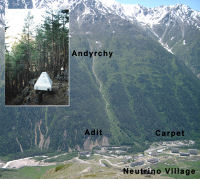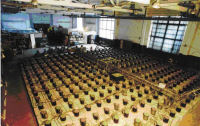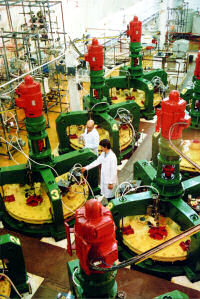INR RAS - main facilities
- Research complex in Troitsk
- Troitsk nu-mass. Unigue Scientific Setup, INR RAS
- Baksan Neutrino Observatory(BNO)
- Baikal Neutrino Observatory
 Baksan Neutrino Observatory
Baksan Neutrino ObservatoryBaksan Neutrino Observatory
is situated in the North Caucasus in the area of the Baksan river at a height of 1700 m above the sea level.The underground setups are located under the mount Andyrchy (3922 m) at different distances from the entrance of the adit which is 4000 m in length.
• the Baksan Underground Scintillation Telescope (BUST) with a volume of 3000 cub.m. at a depth of more than 800 meters of water equivalent (m.w.e);
• the highland setup Andyrchy for detecting wide atmospheric showers which is located above BUST and covers about 5*104 sq.m;
• the ground-based facility Carpet comprising a Large Muon Detector, Scintillation Telescope and Neutron Monitor for studying a hard component of cosmic rays and wide atmospheric showers;
• the Gallium-Germanium Neutrino Telescope with a 50 ton target of metallic gallium and a laboratory for extraction of germanium atoms located at a depth of 4700 m.w.e in the mountain rock;
• low-background laboratories at the depths of 660, 1000 and 4900 m.w.e.
The Observatory is a shared research center for various experiments in the field of fundamental and applied physics.
The underground telescopes are incorporated into the world network observing the processes in space.
 Carpet
Carpet  Adit
Adit
 Gallium-Germanium Neutrino Telescope
Gallium-Germanium Neutrino Telescope
• studies of the internal structure and evolution of the Sun, stars, Galaxy nucleus and other objects of the Universe by detecting their neutrino emission;
• studies of neutrino properties with artificial neutrino sources;
• a search for new particles and super-rare processes predicted by various modern theoretical models at a sensitivity level inaccessible to other methods;
• investigation of high-energy cosmic rays, gamma-astronomy, a search for gravitational waves;
• studies of the influence of cosmic factors on the processes in the atmosphere and on the surface of the Earth.
 Scintillation telescope
Scintillation telescope Low-background laboratory
Low-background laboratory
WWW.INR.RU 2001 © webmasters